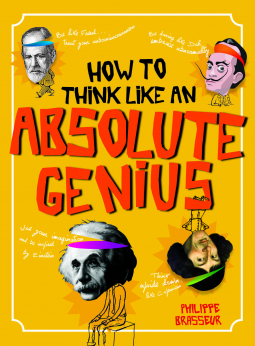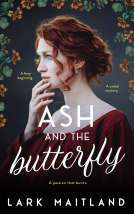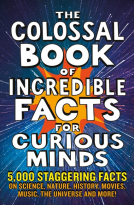
How to Think Like an Absolute Genius
by Philippe Brasseur
This title was previously available on NetGalley and is now archived.
Send NetGalley books directly to your Kindle or Kindle app
1
To read on a Kindle or Kindle app, please add kindle@netgalley.com as an approved email address to receive files in your Amazon account. Click here for step-by-step instructions.
2
Also find your Kindle email address within your Amazon account, and enter it here.
Pub Date Oct 16 2018 | Archive Date Dec 04 2018
Quarto Publishing Group - QEB | words & pictures
Talking about this book? Use #HowToThinkLikeAnAbsoluteGenius #NetGalley. More hashtag tips!
Description
Available Editions
| EDITION | Other Format |
| ISBN | 9780711239852 |
| PRICE | $15.95 (USD) |
| PAGES | 80 |
Featured Reviews
 catherine h, Reviewer
catherine h, Reviewer
I agree with much of what's in this book, but feel I have to include ruthless self promotion and shoving everyone out of your way if they get in your way! But I assume that is'n't appropriate for a children's book! Lol! So genius may not mean as much as we've been taught it means. Over all however, the book is kind of neat in that it encourages kids to think outside the box. I think the activities in it and it may be useful within the classroom! Seriously, Phillippe Brasseur has written a most beguiling book for kids to explore themselves and the world around them! Kudos!
 Vidya T, Reviewer
Vidya T, Reviewer
My Thoughts:
This book is absolute genius, like its title. There is information everywhere, and a how to use this book page makes it easy to, well, use the book and get the best out of it! Read on to find out what I loved about the book.
And the 27 geniuses mentioned – one of them is our brain.
What I loved:
The concept and the presentation: I love that it is geared towards younger audiences and helping them explore the genius mind. But also love that it works for everybody and I can attest to that as an adult reader. As it states in the book, ‘In this book, ideas bounce around in all directions – just like they do inside our heads!‘. And ideas and information do literally bounce off the page, using images and text all over the page, that make the reading of it more fun.
Activities: All the suggested activities and tips provided are so totally doable by children, by themselves or with others (be it family, friends, or classmates), making each and every activity a wonderful learning experience. For example: Train your curiosity by asking yourself 10 different questions on the same topic. The book includes a Take it Further section at the end which is also full of ideas and activities. A list of included Further Resources to help research deeper on information in the book, and a list of activities to make your days, your weeks extraordinary.
The possibilities: The book inspires inspiration, curiosity, take-action steps, and so much more. It enables the reader with information and leads them on a wonderful journey of discovery. The Take it Further section also gives ideas on how to convert your ‘Yes, But’ to a ‘Yes, I Can’ – I loved this!
The creative methods themselves: They are classified under curiosity (take notes like da Vinci), imagination(think outside the box like Igor Stravinsky) and determination (work methodically like Agatha Christie). Each creative method includes:
practical and practicable tips for everyday that will soon become habits leading you onto the path to being a genius.
quotes from geniuses that are relevant to the method and will inspire you into action, like Edison’s words ‘I didn’t fail. I just found 10,000 solutions that didn’t work.’
activities to explore your creativity, over and over again like this one from the book: In the ‘Gymnastics for Writers’ activity, suggestions include 7 challenges, one of them is write 7 sentences with just 7 words to describe the beginning of your day.
a snapshot of the featured genius that helps the reader learn more – information about the person and fun facts too. For example:' Salvador Dali often gave out blank sheets of paper that he had signed, saying: “Here, do a Dali and get rich!“ ' (That is rich indeed!! Oh, to have met Dali when he was handing out those blank sheets!)
other geniuses who also made an impact in their fields, and on the world, by exploring creatively and differently. We learn about other famous as well as not so famous people whose discoveries help us everyday, like Margaret E. Knight who held 87 patents and invented the flat-bottomed paper bag!
a note on how the brain works and what happens when we do different activities, like those mentioned in the book. One example from the book: 'What we see is the brain’s primary source of information. So much so that our sight often overrides our other senses.' So the book suggests to try out some daily activities by closing our eyes.
What could have made it way way better: A couple more woman geniuses highlighted! The book highlights one woman – Agatha Christie. Granted that there are many women included in the book in the ‘Others Who……’ section for each creative method and also granted that the book itself also makes a mention of this (redeeming point for this grievance with the book) -‘So many people mentioned in this book are deceased. You will also find that the majority are male.’ But I would have loved it so much more with at least a couple more women of the women mentioned in the ‘Others..’ highlighted among the 26 (and it would not have hurt to have more than 26 geniuses too!).
In Summary:
A book that would be wonderful in classrooms to use as a learning tool – explore one creative method a week! And at home to read and discuss as a family – I know I would love going through this book even with my older kids – a teen and a tween. There is so much potential in such books.
So, there you go – another wonderful book to gift. Gift it to yourself or that potential-genius (does that not include everyone?) kid you know who loves reading (or not – this book will encourage reluctant readers to pick it up – it is appealingly genius that way!)
Rating: A-
Reading Level: 8 years and older
Reread Level: 5/5
Disclaimer: Thank You #NetGalley and Quarto Publishing for the advance DRC of this book. The opinions are my own.
This is great four star book that talks about the Genius of the past. It describes different techinques to work on being a genius yourself. It teaches you about the Genius of the past, what they did and how they did it. I would recommend it to any who loves history. I am going to purchase a copy of this book for myself.
How to think as an Absolute Genius by Philippe Brasseur is a children's book interested to stimulate in different fields, geniality and potentialities of your children thanks to a lot of advice, tips, but mainly thanks to inspiring past genius.
Advice are many: they pass through notes taken by Da Vinci, Charles Darwin's questions about environment and animals; adopting a different yourself as experienced by Salvador Dalì, imagining the impossible as did John Lennon; trying to be inspired by the past: an eminent painter in this sense was Pablo Picasso; or just trusting your subconscious; asks at Sigmund Freud; creating continuously as did Marcel Proust; cultivating dreams as Martin Luther King did with his motto: "I have a Dream" but try also to work in a team like Walt Disney if you have a creative spirit in grade of sharing.
Wonderful illustrations, beautiful colored book, I know that this one will be an appreciated gift for your children because it will speak directly to them and their potentialities.
Children love to be loved and appreciated, feeling that their parents trust them and their endless possibilities.
Highly recommended.
I thank NetGalley and Quarto for this eboo
I enjoyed this book and learned a lot of things from it! Thank you netgalley for the free arc in exchange for an honest review!
How to Think Like an Absolute Genius introduces children to great minds throughout the ages. From Da Vinci to Darwin and many in between, the reader is engaged through a two page spread of photos, sketches, and activities they can try themselves. Fun to flip through it use for projects.
Readers who liked this book also liked:
Nigel Henbest; Simon Brew; Sarah Tomley; Ken Okona-Mensah; Tom Parfitt; Trevor Davies; Chas Newkey-Burden
Entertainment & Pop Culture, Humor & Satire, Nonfiction (Adult)












